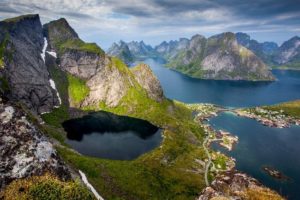“The first infrastructures of this type were built at the end of the 19th century, and at present there are nearly 200 underwater tunnels built worldwide. Although some are used for water and electricity supply, most are used to house road or rail connections. Despite the adversities in their approach, the manufacture and maintenance of these constructions are not overly complicated, and yet they can provide an effective and sustainable solution to maritime transport”
Certain geographical contexts, such as the fjords of Norway or the morphology of Japan, require a specific solution to deal with large bodies of water that hinder communication. Underwater tunnels are a very convenient resource for these situations: structural design techniques have advanced significantly in recent years and, once built, their operation and maintenance are barely different from terrestrial infrastructures. To this end, and as Vicent Esteban Chapapría, PhD in Civil Engineering, points out, each case and each specific situation must be analyzed. “From a strictly technical point of view, the solutions are within the reach of the most advanced engineering, or they can be if the will to carry out the projects is there. The first aspects to be addressed are the social and economic opportunity, the financial viability, and the desirability of undertaking the difficulties that will undoubtedly arise,” he warns.
Although there are previous solutions that remain fully valid and are used successfully, such as bridges, tunnels over these distances provide safety, speed, and a reduced environmental impact. “Historically, underwater tunnel projects have had great appeal, although they sometimes had to be abandoned because of the titanic effort involved at the time. For example, as reported by The Telegraph, in 1889, a project to build a steel line between England and France was proposed, of which a model was made and presented at the World’s Fair in Paris. They had to wait until 1994 to build the Eurotunnel,” he says.
With the current pace of engineering, the risks assumed in the project and construction phases in terms of safety have been reduced significantly, and the capacity to establish this type of connection is very nearly unlimited. However, the fact that it can be done does not mean that it is always the best solution. “We can say that any project is possible, but it is another thing for the scale and scope to end up being profitable, not only in economic terms, but also in a rigorous cost-benefit analysis. Obviously, we must work hard on the design and preliminary study before entering the implementation phase and, in doing so, we will be able to check the real viability and profitability of the project from all possible approaches,” he says.
Construction and impact on the environment
As Esteban Chapapría explains, there are three types of underwater tunnels: those dug in the seabed, dredging (with the subsequent placement of prefabricated units), and underwater floating tunnels. “In the first example, engineers gradually create a tunnel starting from land, so that it is always dug under the seabed, with a thickness that guarantees that there will be no water infiltrations or similar problems and, therefore, its stability,” assures the expert. Dredging, i.e. direct excavation, has become an especially attractive option in recent decades. There are dredges capable of excavating at great depths –generally tens of meters, although they can also reach hundreds– and the exposure of workers to risks during construction is considerably reduced, since they are manufactured on land and then installed on the dredged bottom.

The large interconnection project to be placed in the Norway fjords envisages the use of floating tunnels placed at mid-depth.
The large interconnection project to be placed in the Norway fjords envisages the use of floating tunnels placed at mid-depth. Furthermore, “recently, floating tunnels have begun to emerge. These prefabricated infrastructures are placed at mid-depth and are attached at one end to the seabed and at the other to floating elements, which means they are suspended at a certain depth, always below sea level. This is the case with the large project in the Norway fjords, for example,” says Esteban, who explains the basic assurance procedure. “During the planning and construction phase of the tunnel, extraordinary measures are taken to safeguard the project, which involves mechanical excavations using large moles that operate on materials under the seabed. Safety and maintenance systems are installed once the tunnel is finished. There is no excavation involved in the case of the floating tunnels, which means prefabricated elements can be installed rather simply. These are placed at a certain depth and suspended and attached to the bottom. These techniques are more typical of offshore oil exploitation structures.”
The distances that can be bridged by this type of infrastructure depend on each case, and it can be said that there are no longer any fixed or exact rules. “For example, replacing the failed Celtic Crossing Bridge between Scotland and Northern Ireland with an underwater tunnel would present many technical difficulties. It is a 45-kilometer stretch of the Irish Sea, where some sections are at depths of up to 300 meters. But that is not all: the bed contains bombs and sunken mines from the Second World War, and the sea passage has intense traffic,” says Esteban, who explains that the key to everything is not a question of length, but of efficiency and geostrategic opportunity. “The Eurotunnel between Calais and Folkstones is 50 kilometers long, and China has four high-speed train bridges that are over 100 kilometers long.”
“Opening communication channels and doing so in a sustainable way, by reducing the impact, will always be a success for engineering and Civilization”
Applications and potential uses
According to their activity, we can distinguish three types of underwater tunnels: road, rail, and fluid piping. In the North Sea there are a large number of units for oil exploitation, which originate from the platforms. This concept can also be applied to the area of Scotland and Norway. There are also other cases of tunnels transporting gas for supply, including an important underwater gas pipeline in the area connecting China and Russia. However, the most common use is still transport, both rail and road. Initially, the most numerous were, of course, road tunnels. Later on, railway connections began emerging, such as the connection between France and Great Britain or the islands of Tokyo.
The factors that determine the type of infrastructure to be made depend on the setting, orography, depth, and geology. In other words, the location. “But the choice between alternatives is made by evaluating them and assessing the benefits and drawbacks of each one. We must be conscientious, prudent, and honest professionals. In order to do this, engineers study all the impacts, costs, and effects. The fact that engineering is increasingly offering more and more services should not lead us to undertake all kinds of monumental works. With an open mind, we must consider and analyze in depth how appropriate it is to undertake each project,” explains the expert, adding that we are dealing with a technology that has a long history, and that the future will open up countless possibilities that are unimaginable as of now. “There is talk of projects on Mars or in faraway places. For example, in October 2019 the American Society of Civil Engineers (ASCE) met in Miami, where a project to address Climate Change called “Future World Vision” was presented. The project proposed the construction of floating cities in the sea, separated from the coastline and with many services and underwater connections,” he adds.
However, he stresses that these alternatives for the future cannot set aside all the challenges we are facing at the moment. “We must not forget the problems of everyday life: traffic and mobility in cities, urban growth, pollution, energy transition, and many other everyday problems we can prioritize by providing work, talent, and creativity.”
In the current context, the expert supports floating tunnels, one of the technologies with the best prospects. “I believe that, technologically, they are highly advanced and are a solution that also has less impact. Unlike fixed units, these could even allow for a certain amount of dismantling, and that could mean greater sustainability. We have all the construction and operational technology, we have a lot of information on how they respond, even in very adverse maritime conditions (thanks to the examples in the North Sea), and, as they are all monitored and there are large numbers of people working on them, there is a lot of information on their performance.”
Transferring experience from the offshore platform system to solutions for transporting people or goods is one of the most interesting approaches at the moment, and the maintenance and monitoring systems they require are practically the same. “The maintenance work consists of replacing elements subject to the action of the sea, seeing if they respond and, if not, replacing them. These are challenges that, in view of the experience with all the oil platforms in operation, are being transferred to land or underwater connection systems.” In conclusion, dismantlable infrastructures have less environmental impact, especially on the landscape, and less effect on the coastal areas they connect. They may be necessary, or even indispensable, for several reasons: maritime traffic, ocean currents, fishing and various circumstances relating to the preservation of the seabed or the marine environment.
Preventive maintenance
The maintenance of an underwater tunnel uses techniques and technologies similar to those used with a land tunnel, although engineers must take into account different risks, such as the measurement of currents, ocean variables, or the control of the seabed. As the expert points out, in this type of infrastructure, the main risk faced is flooding due to leaks or possible ruptures; one of the most extreme variables is the possibility of earthquakes, which can generate greater problems in the case of an underwater installation. However, the monitoring and tracking equipment and systems are similar, although data processing, acquisition technology and processing are much more developed and applied more in the case of underwater tunnels.
“For example, in seismic monitoring, we measure primarily when it occurs and what acceleration forces it produces. Monitoring in this aspect is extreme and is based above all on equipment –accelerometers– that measure whether there is a sudden change in the acceleration of gravity. A detonating vibration can cause an acceleration force on the structure and damage it. On the one hand, we must ensure that the design is anti-seismic, and on the other hand, we must check the effects of a possible earthquake so that they are not destructive,” he says.

Maintaining low risks in all this type of work, the instrumentation is mainly aimed at guaranteeing the stability of the structures.
There are also meteorological sensors that measure temperature and humidity. All these devices collect an infinite amount of data apart from real-time monitoring, both on acceleration forces and on possible movements or displacements produced by them. This technology “is being used a lot in Norway, Chile, and Tokyo, where there is a high risk of earthquakes and where vigilance is now fundamental,” he says.
Apart from natural risks, those derived from accidents, mainly fires, or small incidents such as lack of ventilation –a constant in any tunnel– are taken into account. Once the alert is triggered, the response to these alerts is done through protocols that depend on the data system. “Nowadays this has improved a lot thanks to the monitoring systems inherent in communication technology, and the response usually occurs in a matter of minutes,” explains Esteban Chapapría, who adds that in the case of necessary evacuation “many underwater tunnels have several parallel pipes that intercommunicate every given distance, allowing escape routes to be created.”
Irrespective of all the automatic mechanisms, the final decision is still in the hands of the people. “Although there are automated procedures based on intelligent systems, the engineers are in charge of analyzing the data and drawing up the protocols. In other words, at present the design of the protocols and the final decision is still carried out by humans. There is always real-time monitoring equipment acting on the tunnels, as in any other infrastructure operating with risk, such as a nuclear power plant.”
Maintenance and prevention tasks have been notably improved over the past few decades, and new technologies give rise to superior improvement when all the assurance mechanisms see widespread implementation. “In times past, when there was more uncertainty, the solution was always to make infrastructures more robust, more resistant. On the other hand, nowadays, to keep risks low in these types of projects, they are provided with instruments to check maintenance needs and to guarantee mainly the stability of the structure. In prefabricated tunnels, the requirements and monitoring of the joints and connections between the different elements are unique. But in any case, the aim is that there should never be a net loss in terms of the quality of the project, but rather a substitution of elements,” he concludes.

Vicent Esteban Chapapría contributed to this article. PhD in Civil Engineering (Polytechnic University of Valencia-UPV, 1978 and 1987), he worked as a consultant in several companies and as Chief Engineer of a port until 1989, when he was appointed Professor of Ports and Coasts at the UPV, after having worked as a Professor of Ports at the UPM since 1987. He has acted as Director of the School of Civil Engineering and Vice-Rector of Studies and European Convergence at the UPV.
His lines of research have focused on maritime, port, and coastal engineering, port-city relations, nautical tourism, and sustainability of the coast. He has participated as a researcher in 19 projects in public tenders and 55 research contracts and has collaborated in some 40 conventions.
He has published nine books, more than 65 Papers at Conferences and more than 120 articles in national and international magazines on maritime engineering and nautical tourism.
He has been a member of the Board of the Central Dredging Association and of the board of the Scientific Committee of RETE (International Association for the study of the Port-City Relationship) and has sat on several Editorial Boards of magazines, scientific committees, and the Public Works Magazine. He was chairman of the Association of Civil Engineers from 2016 to 2020, having served on its governing board since 1999.





